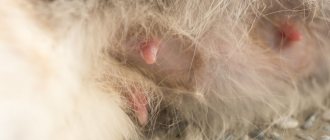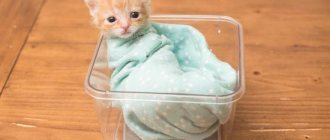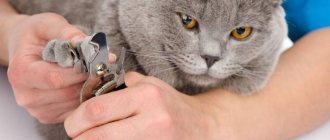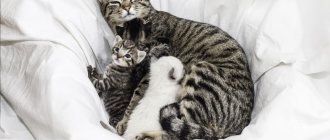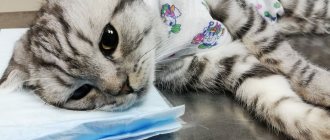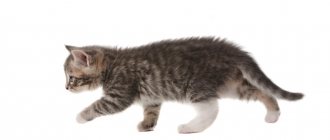For a beginning breeder: at what time can a cat become pregnant?
When a fluffy, uncastrated young beauty lives in the house, sooner or later the owner is puzzled by the question of what time the cat can become pregnant. Knowledge in the field of physiology, understanding of the characteristics of sexual behavior, and the nuances of reproduction will help you competently approach the problem of keeping and breeding a pet.
Read in this article
Features of cat pregnancy
On average, pregnancy in a cat of any variety, be it British shorthair, Scottish fold or fluffy Persian, lasts 62-63 days. If an animal bears offspring and gives birth for the first time, the period may be shorter - 56-58 days. Multiple pregnancies often lead to premature birth, and when a mother cat is carrying one or two babies, she can walk in the position for the maximum period possible. In the latter case, the offspring are born healthier and larger than from a litter with many kittens. Kitting is also easier and faster for a cat, so a low-fertility pregnancy is preferable.
Age at which a cat can become pregnant
The cat family is distinguished by its early maturity and fertility. This is also true for pets. A number of factors will influence when a cat can become pregnant for the first time:
- breed affiliation,
- heredity,
- individual characteristics,
- others.
The average cat has her first heat, and with it the opportunity to become pregnant, occurs at 6 - 8 months. Later, large breeds and those with long coats mature. In representatives of such breeds as Maine Coon, bobtail, Siberian, Norwegian forest cat, the first heat occurs at 12 - 14 months. Short-haired breeds, as well as outbred animals, can mature before 6 months. Often the first heat is observed at the age of 4 - 5 months. This should be taken into account when keeping a young female in the house.
Large breeds of cats mature later, their first heat occurs at 12-14 months
From the moment of the first heat, the pet is physiologically ready to become a mother and retains this ability for almost the entire adulthood. There is no such thing as menopause in the cat family. The reproductive period begins with the first heat and can last until death. Owners of furry pets should be aware of this feature in order to understand that the answer to the question of how many months a cat can become pregnant is quite simple - immediately after puberty.
How many kittens can a cat give birth to?
Cats reach sexual maturity at approximately 8-9 months. And before the age of 1 year, she is already able to become pregnant and bear offspring. However, experienced breeders understand that this is quite early, and consider such births to be risk factors, since the body is still too young.
Note to the owner! It is not recommended to breed domestic cats under 1 year of age, although in the case of backyard dwellers we cannot in any way influence this fact. It is advisable to wait until the cat is one and a half years old, when the cat’s body is stronger and ready to bear healthy offspring.
When is the best time to meet a cat?
Despite the rapid puberty of the pet, there is no need to rush into mating. The onset of the first heat only signals the physiological readiness of the cat’s body to perform the reproductive function. When a cat can become pregnant is decided first of all by the owners, unless, of course, the animal has free access to the street. Responsible breeders plan matings in advance. Before mating, the cat and male cat must be examined by a veterinarian for hidden infections, be vaccinated, and treated for worms and external parasites.
The task of the animal owner is first and foremost to preserve the health of the pet. That is why experienced breeders and veterinary specialists believe that the first estrus should under no circumstances result in the animal becoming pregnant. A young body must get stronger and take shape. Pregnancy, childbirth and feeding offspring require a lot of effort. Therefore, by the first conception, the female must be absolutely healthy, in good physical shape and fully developed physiologically. In this regard, the question often arises: when can a cat give birth for the first time?
Is it possible more often? Arguments for"!
How many times a year can a cat give birth? There is no consensus on this matter even among specialists and veterinarians. Some insist that endless childbirth exhausts the animal and deprives it of health, hence the conclusion that the cat needs rest.
Others strongly disagree. Purrs do not have “critical days.” Therefore, “empty heat” causes the animal no less suffering. The cat screams, loses weight, rolls on the floor, loses its fur. As a result, her psyche is disrupted, diseases and tumors appear. That is, estrus without mating undermines the health of the animal no less than the next birth.
Many cats painfully endure an unsuccessful estrus, and their health worsens. How many times a year can a cat give birth if she is young and healthy, easily tolerates pregnancy, gives birth on her own and without problems? It can be knitted more often - up to 3-4 times.
Some experienced breeders do just that: they “allow” their cat to give birth to offspring three or four times a year. But all this happens under the strict supervision of a doctor. The meowing mother is provided with proper, nutritious nutrition and is given vitamins. This allows the cat to remain in good physical shape, and its offspring are born strong and healthy.
It is incorrect to compare a cat with a person. Nature designed animals differently. If you let her give birth once a year, and not regularly, then childbirth can be very painful and problematic.
How long after giving birth can you plan to conceive?
After giving birth, a cat usually comes into heat within 1.5 - 2 months. Often signs of heat are observed earlier - 2 weeks after lambing. However, you should plan your next pregnancy no earlier than 5–6 months. Even if the previous lambing and birth passed without complications, the pet must regain strength. Bearing kittens and labor are associated with large losses of nutrients and minerals. The mother loses a lot of calcium, phosphorus, and vitamins, giving these and other components to the formation of the offspring. In addition, the female should regain her weight and normalize her hormonal levels.
In this regard, responsible and competent breeders recommend planning the birth of a purebred pet no more than once every 1 - 1.5 years. This interval between births will allow you to restore strength and improve your health for the next pregnancy.
Is it possible to increase the number of kittens in a litter?
This question is usually of interest to breeders involved in breeding kittens for sale, since the expected profit depends on the number of offspring, as well as covering the financial resources spent on mating (treatment, testing, raising, feeding).
Depending on the regalia of the inseminating cat, the cost of mating can reach up to 10 thousand rubles. At the same time, owners of males are often not interested in the number of offspring. They receive money for mating, and the rest does not concern them. This position is fundamentally wrong: both parties should be interested in a good offspring. Before you give money for mating, ask:
- how often the cat is used;
- is he eating well? whether he has diseases of the genitourinary system;
- how many kittens are usually born from a male cat;
- Does the cat suffer from cryptorchidism?
To increase fertility, experts recommend injecting cats with the following drugs before breeding:
- Ovariovit: a homeopathic medicine that restores ovarian function, regulates the sexual cycle and increases fertility.
- Gamavit: anti-stress, immunostimulating drug, supports the vitality of the body, has a positive effect on eggs.
- Vitamin E: has a beneficial effect on the reproductive system, prevents infertility.
There is a special scheme designed for 10 days, which is often used for cats:
- Ovarium: 0.5 cc is administered subcutaneously once a day.
- Ortilin: 1 tablet twice a day.
- Ovariovit: 1 tablet 2 times a day.
- Vitamin E: 1 capsule twice a day.
- Gamavit: 1 cube per day subcutaneously.
- Catozal: 1 cube per day subcutaneously.
How often do cats give birth?
It is no coincidence that the cat family is considered one of the most prolific. This fully applies to home beauties. Over the course of a year, a sexually mature cat can give birth 4 to 5 times. This frequency is typical for animals with free access to the street. In the absence of control over sexual behavior, pregnancy can occur even in a nursing cat. This leads to exhaustion, weight loss, curvature of the spine, and the development of inflammatory diseases of the reproductive organs.
If the owner approaches breeding issues responsibly, he will not allow her to become pregnant during every heat. There should be a rehabilitation period of at least 4 to 5 months between births.
How to prevent pregnancy in a nursing cat
If the owners do not breed offspring, it is recommended to sterilize the animal. For most breeds, the optimal time for the procedure is 6-12 months. It is possible to perform surgery on a nursing mother to prevent unwanted fertilization.
Contrary to misconceptions, a nursing cat can become pregnant
In addition to surgical intervention, you can give your pet medications based on medicinal herbs (for example, Fitex). It is necessary to monitor your pet's behavior, especially if she goes into heat after giving birth.
The most successful option is to exclude the female from communicating with cats.
Important! Do not use alcohol tinctures or valerian. These remedies do not calm the cat's desire, but only intensify it.
When is a pet no longer capable of producing kittens?
Many owners, interested in breeding issues, want to know when cats stop giving birth. The peculiarities of the sexual behavior of domestic beauties allow them to continue their feline lineage throughout their lives, until very old age. Older pets usually give birth to fewer kittens than young animals. Nevertheless, pregnancy also occurs in an older cat by cat standards.
The owner must take a responsible approach to breeding issues and not allow mating of animals older than 7 years. Once your pet reaches this age, she should be sterilized. This point of view is shared not only by veterinary specialists, but also by experienced and competent breeders. No self-respecting breeder will produce offspring from a cat older than 6-7 years. And this is justified not only by the problems of obtaining high-quality offspring of a particular breed, but by care and love for the fluffy beauty. After all, pregnancy, childbirth, and feeding kittens do not improve the health of an elderly female.
A cat gives birth for the first and second time: how many kittens will there be?
It is usually important for owners to know how many kittens will be in the litter. Thanks to a preliminary forecast, you can immediately solve a lot of practical problems.
The place, with what parameters to prepare for a cat with kittens, what kind of assistance should be provided to a woman in labor during the lambing process, how many kittens should be distributed.
It is almost impossible to find out exactly how many kittens a cat gives birth to the first time and the second time. There are unspoken “calculators”, but they rarely work.
On average, the first and second litter can produce from 4 to 6 kittens.
The number of kittens can be more than 10 or less than 4 - it all depends on many factors:
- Too young, old cats produce up to 4 babies in one lambing. The maximum number of offspring is between the ages of 3 and 6 years.
- Heredity and the breed of the animal significantly influence the number of kittens. The rarer the breed, the fewer kittens the female will give birth to at one time.
- The conditions in which the female is kept, nutrition and care all significantly affect pregnancy and the process of conception.
- Male genetics, sperm quantity, quality of sexual intercourse.
- Hormonal background of the female at the time of conception, previous diseases.
Several of the above conditions may simultaneously affect the quality and quantity of future offspring.
Drugs to protect against pregnancy
Knowing how cats become pregnant, the owner should also have an idea about methods of contraception. Issues of contraception arise especially acutely for owners of purebred animals during the rehabilitation period. There are many oral contraceptives for domestic cats on the pet market. The most popular of them are the following:
- “Sex barrier”;
- “Stop-intimacy”;
- “Counter-sex”;
- “Gestrenol”;
- "Libidomin"
Contraceptive injection
Is it possible to increase the number of kittens in a litter?
Actually it is possible. You just need to start early, even before the planned pregnancy and mating. You should not rely on hormonal drugs that can disrupt hormonal levels. There are also a lot of homeopathic medicines (ovariovit, gamavit, for example). They help restore ovarian function, which has a beneficial effect on the formation of eggs in greater numbers than before stimulation.
The use of vitamin E (tocopherol acetate) and the microelement selenium has a good effect (you need to be very careful with selenium, since it is poisonous in large doses). Therefore, never try to prescribe any therapy for an animal yourself without seeking an in-person consultation with a veterinarian.
Improve feeding and housing conditions. Let the cat rest more.
The cat is in heat
Estrus in cats is a very sensitive process that causes a lot of trouble, both for the cats themselves and for their owners, so estrus in cats requires special attention.
Estrus in cats: what is it?
A cat's estrus or, scientifically, the reproductive estrous cycle is a special physical and emotional state that occurs in cats during sexual heat, i.e. sexual arousal. During estrus, the cat's body prepares for mating (mating), fertilization and pregnancy.
Stages of estrus in cats
Estrus in cats occurs in several stages:
1) Proestrus (1-3 days)
During this period of estrus, the cat shows anxiety, her behavior changes, she begins to scream - this is how she attracts a sexual partner. At this stage, the cat is already interesting to cats, but does not yet allow them to approach her. If a cat appears in a cat's life during proestus, then this period quickly ends.
Estrus itself, during this period mating (mating) occurs. The cat actively communicates with cats and does not drive them away. A cat in estrus does not look like itself, its behavior can be completely inappropriate. Again, this period passes in a short time if the cat is introduced to the cat.
3) Diestrus (metestrus, interestrus) (2-19 days)
The cat's sexual arousal subsides, and she begins to treat cats aggressively. If ovulation and fertilization have occurred, then the cat becomes pregnant during this period. If ovulation occurs but fertilization does not occur, the cat may experience a false pregnancy. In other cases, after some time, estrus resumes, starting with proestrus.
A period of long absence of estrus, the so-called. sexual rest. Usually, it occurs in winter and summer.
At what age does a cat go into heat for the first time?
On average, a cat goes through puberty between the ages of 6 months and 1.5 years. Cats with light bones (Cornish Rex, Siamese, Orientals, etc.) mature earlier - at 4-8 months, cats with medium bones (British, Scots, Kuril Bobtails, etc.) mature at 8-12 months, cats with heavy bones (Siberians, Maine Coons) - at 10-18 months.
It is best to spay a cat after the onset of puberty, but before her first heat. Cats can be bred after 10-18 months, depending on the breed and degree of maturity. A cat, a cat should NOT be bred during its first heat! Early pregnancy can lead to complications.
A cat's heat: how long does it last?
In the presence of a cat, estrus in cats passes in 5-7 days, and in his absence it can last 10-15 days.
It should be borne in mind that, presumably, 10-12% of domestic cats suffer from nymphomania, i.e. They have one heat flow smoothly into another without any pauses. This is especially true for Siamese-Oriental cats and other light-boned cats (Cornish Rex, etc.).
However, both a prolonged delay in estrus (not related to seasonality or the aging of the cat) and incessant estrus in a cat is a reason to take the animal to the veterinarian, since the causes of cycle disruption can be tumors, cysts of the genital organs, purulent inflammation of the uterus (pyometra) and other diseases . The risk of their occurrence increases significantly if the cat is not bred with a cat for a long time.
Estrus in cats: how often does it happen?
It is believed that periods of increased sexual activity in both male and female cats occur in spring and autumn. During these periods, cats come into heat every 1-2 weeks. However, scientists believe that the sexual activity of cats is influenced by the length of daylight hours: the day increases - activity increases, the day shortens - activity decreases. Since domestic cats live mainly under artificial light, this pattern is not always observed, and sexual activity can remain at a high level all year round.
Estrus in cats stops during pregnancy (not always, they are possible at different stages) and begins again 3-3.5 months after the birth of kittens. If kittens are stillborn or die immediately after birth, estrus begins earlier. In rare cases, the first heat after birth occurs in a cat already on the second day of lactation (feeding).
Heat during pregnancy
In the early stages of pregnancy, cats may go into estrus due to hormonal imbalance, so estrus a week or two after mating does not always mean that pregnancy has not occurred.
If a cat is in heat during pregnancy, and she mated with a male cat, then most likely she will become pregnant again. Thus, embryos of different ages will simultaneously appear in the cat’s uterus. Usually, younger kittens are born together with older ones and die due to prematurity; less often, younger kittens are born after the older ones (a few days later), in which case they are quite viable.
Behavior of cats during estrus
During a cat's heat:
• Screams loudly (especially in the morning, evening and night) as if she is in great pain (in fact, cats do not experience pain during estrus).
How does childbirth take place and how many hours?
In order for your cat to lamb without complications and for all the kittens to be alive and healthy, you need to help your pet.
Every pet owner should provide assistance correctly and efficiently, and know the main stages and features of childbirth.
To cope with childbirth in a cat, it is enough to familiarize yourself with the process using special literature.
If an animal develops complications before or during birth, you should definitely call a veterinarian.
How does childbirth occur in a cat?
- The first stage is determined by the beginning. Contractions can be determined in accordance with the behavior of the animal. The female begins to look for a suitable place, constantly hangs around the owners and becomes noticeably nervous, experiencing painful sensations.
- After the end of the first stage, which lasts from 12 to 24 hours, the time comes for the second. At this moment the attempts begin. The cat no longer moves, the amniotic fluid is leaking. At this moment, it is advisable to stay near the pet for as long as possible.
- The cat does not need help during the birth process. It is enough to accept the kittens and lay them down so that the new mother cannot crush or injure the babies. If the kitten walks not with its head, but with its legs forward, then the animal needs help: slightly pull the kitten by the paw forward, and then down.
Lambing will end in about 1-3 hours. The young mother will begin to lick and feed her offspring. To prevent the animal from getting up again, you need to place food and drink nearby.
For the first 3 days, it is worth closely monitoring the health of the female and the offspring. During this time, problems or pathologies will appear that may affect the further quality of life.
Useful video
Share this post
- Related Posts
- Using laundry soap for washing dishes: benefits, harms and composition of the product
- How to descale a kettle with vinegar, citric acid and Coca-Cola, and why does it form?
- How to prevent shoes from slipping in winter: tips
- What are the medicinal properties of burnet and how to use it correctly
- What to do if a mercury thermometer breaks in a room at home or in the bathroom?
- House flowers: catalog with names and photographs, plant care and the most unpretentious types
Discussion: there is 1 comment
- Motherinstvo.Info:
09/15/2018 at 02:11The article contains all the necessary information for the owner of the animal, supported by a photo in order to learn how to distinguish a cat from a cat. It will also be useful to learn how to properly feed a kitten at 10-12 weeks.
Answer
When does puberty occur in cats?
The most important stage in a kitten's development is puberty. During this period, the animal's body undergoes many physiological changes. Ultimately, the pet acquires the ability to reproduce. In felines, the onset of sexual activity depends on factors such as:
- breed;
- feeding
- individual characteristics;
- conditions of detention.
A cat rolling around on the floor indicates an approaching heat.
Early puberty occurs in some families of cats. It is characteristic of oriental breeds, in particular, the Siamese-oriental group and the St. Petersburg Sphynx. Also, pets with thin bones and kittens born in the first half of the year have early sexual maturity.
For your information! Domestic Scottish cats become sexually mature earlier than domestic cats. However, these folds mature later than the kittens that are kept in foster homes.
How to prepare a cat for mating
To increase the number of offspring, some veterinarians recommend giving your pet a course of the homeopathic drug Ovariovit before mating. Its effect is to restore ovarian function, also regulate the sexual cycle and increase fertility.
Gamavit - this drug has a positive effect on eggs, gives strength to the body as a whole, and has an immunostimulating effect.
Caring mother
Vitamin E generally has a positive effect on the reproductive system. You cannot select medications for your animal yourself. Important! First consult a veterinarian who will select the required dosage and combination of drugs.
You can also prepare the cat for the upcoming mating. B vitamins are good for him; after such a course, the body’s activity and endurance are noted, which will have a positive effect on future offspring.
Age at which a cat can become pregnant
Many people wonder at what age a cat can become pregnant for the first time. Puberty can begin between 4 and 12 months of age during the first heat cycle. In individuals of different breeds and body types, the first heat does not appear at the same time. In the case of long-haired and large cats, it occurs when their age reaches 10-12 months. These cats include Norwegian, Siberian and Maine Coon. Small cats with short hair have an earlier development. They become sexually mature at the age of 4-5 months. Representatives of shorthairs are “British”, Siamese and Burmese cats.
Estrus is the name given to discharge from an animal's genitals. The following signs may indicate that heat is approaching:
- the pet's desire to receive more affection;
- friction against the owner's legs;
- rolling on the floor;
- tail wagging.
Important! Outdoor cats go into estrus 2 times a year in spring and autumn, and domestic cats - every month.
The pet's body weight increases by 2-2.5 kg. Females are characterized by various external changes. However, people who got a cat for breeding should know that the onset of puberty does not mean that the female can already mate to produce offspring. The body of a cat less than 10 months old will not be able to bear and give birth to kittens for physiological reasons.
After the onset of heat, the following behavioral and physiological changes are also noticeable in females:
- long and loud meowing. A cat may make loud noises all day long;
- frequent licking. This way the cat removes clear secretions;
- enlargement of the genitals. This will be indicated by a change in gait and frequent trips to the litter box;
- adopting a mating position. The female's readiness to continue the race is indicated by the lowering of the front part of the body and raising of the back. At the same time, she moves her tail to the side;
- marking the territory. This is a method of attracting cats that are sensitive to pheromones that are released from urine;
- excessive affection or aggressiveness. The animal tries to gain more attention from the owner, wants to be petted, or begins to react aggressively to the owner’s affection;
- desire to go for a walk. During the sexual hunt, the cat every time tries to get out into the street through a door or window.
What determines the number of kittens?
- The very first factor is age. As already mentioned, a small number of young individuals, primiparous and old-parous, give birth.
- Hereditary factor. If the expectant mother was from a large litter, then the chances of giving birth to many kittens increase, and vice versa, if the litter was small, then you need to expect few kittens.
- The pet's health status. Weakened cats that do not receive the necessary vitamins and do not have adequate nutrition are physically unable to bear and give birth to many kittens; they usually give birth to up to 3 babies. Healthy and active
- Pedigree cats give birth to fewer children than their outbred counterparts.
- Conditions of detention. Cleanliness, comfort, stress-free life.
- Nutrition. It must be balanced and complete; if there are no nutrients in the cat’s body, it will be difficult for her to become pregnant.
- The presence of infectious diseases can affect the ability to conceive and bear healthy offspring.
- The cat's temperament plays an important role. The more love games that happen between him and the cat, the higher the probability of fertilization of more eggs, which directly affects the number of offspring.
We invite you to read: List of main claw diseases in cats: symptoms and treatment
When is the best time to meet a cat?
It is important to know when a cat can give birth for the first time. You should only let her near the cat when the genitals are fully formed. For the first mating, the best age is from 10 to 15 months. If you follow these rules, there will be many newborn healthy kittens, and the mother’s body will not be harmed.
Important! It is not recommended to delay the first mating for up to one and a half years. Experienced breeders advise skipping the first 2 heats and then untying them.
Late insemination can disrupt the reproductive cycle. The following problems may arise:
- stress;
- sudden weight loss;
- inflammation of the uterus;
- false pregnancy;
- polycystic disease
It is necessary to ensure that the animal does not produce offspring more than 3 times a year. To obtain purebred offspring, the appropriate male is selected from professional breeders. Before mating, you should familiarize yourself with some rules and subsequently adhere to them:
- It is prohibited to use drugs that affect estrus. Hormones are enemies that lead to the emergence of dangerous diseases;
- the pet must be vaccinated against rabies, panleukopenia, rhinotracheitis, calicivirus before mating. This must be done a month before mating. Additionally, your cat can be vaccinated against chlamydia and lichen;
- treatment for worms must be carried out 14 days before mating;
- On the day of mating, the female, like the male, has her claws cut off. This is necessary to avoid injury if the pets behave aggressively;
- Bathing your pet should be postponed before meeting the cat. Soap destroys the scent of natural pheromones that attract males.
Important! You need to prepare in advance everything you need for the expectant mother and her kittens.
Signs of unfinished labor
Before taking action, you need to check whether the cat can give birth to not all kittens at once. The situation can be found out by observing it. Signs that not all kittens have been born include the following:
- Mom lies on her side without changing position. There is little or no interest in children;
- the cat does not want to eat or drink;
- when observing an animal, you can periodically see how attempts occur;
- if you carefully palpate the tummy, you can feel a strong muscle tone;
- the mother has had a fever for a long time;
- Blood discharge is noticed from the uterus, during which an unpleasant odor can be felt.
Important! If there is an assumption that not all babies were born, it is necessary to call a specialist as soon as possible and send the cat to a veterinary clinic. In such cases, an ultrasound examination is performed to clarify the clinical picture and measures are taken according to the situation.
Bleeding may mean labor is not over
When a cat gives birth, it is important to make sure everything is successful in the end. This can be judged by the presence of the following signs:
- As soon as the mother realizes that all the kittens are out, she begins to actively care for the offspring, feeding them milk. At the same time, the cat intensively licks the babies, feeds them, purrs;
- If you listen to your breathing, you will find that it is even. Heart beats and pulse are rhythmic and follow at a normal speed;
- Mom eats and drinks with pleasure;
- the pet is able to get up and walk at least a little;
- when labor ends, if palpation is done no earlier than 40 minutes later, the abdomen will feel soft and relaxed to the touch. When palpating, you cannot feel the presence of seals. The muscles may be tense for a short period of time, but this quickly passes.
An indirect sign of a favorable end of labor may be the natural and calm behavior of the pet. However, it is normal for some cats to remain calm even when giving birth.
If the fetus remains in the birth canal, then this situation is dangerous for the animal. This means that it is dead and will sooner or later begin to decompose. One possible consequence of this is the loss of the ability to give birth to kittens.
We suggest you read: Description of cats with big ears
Important! If the necessary help is not provided in time, this can lead to the death of the pet.
The use of special veterinary drugs can provoke additional labor pains and contribute to the birth of the baby. For this purpose, administration of oxytocin at a dose of 0.3 mg can be used. This should only be done as recommended by a veterinarian.
When using this type of product, it is necessary to take into account the possible allergic reaction of the animal.
If the last kitten cannot be born, the cat needs urgent help from the owner
Features of cat pregnancy
A pregnant cat should receive more care and attention. The most common signs of a pregnant cat are:
- coloration and enlargement of the mammary glands. A similar symptom appears during the first pregnancy. The mammary glands are distinguished by a red tint and swelling. They also become hot and increase in size. Usually this can only be seen on the nipples below;
- increase in sleep duration. Normal cat sleep is 14 hours a day. A cat carrying kittens begins to sleep 2-4 hours more than usual;
- increased or decreased cat appetite. From the outside it may look like she is eating for two. Also, her appetite may disappear completely. The cat will not eat solid food, but only drink;
- nausea and vomiting. Most often the urge occurs in the morning. This can happen 3 times a day;
- frequent visits to the toilet;
- manifestation of aggression. The cat experiences hostility towards other felines from the first week from the moment of conception;
- turning into a homebody. The cat increasingly prefers to stay at home;
- weight gain, appearance of a belly.
A pregnant cat becomes apathetic towards others
On average, cats bear kittens for 56-71 days. However, these are not exact numbers, since they can also give birth to kittens premature or post-term. Gestation periods may also vary depending on the breed. Long-haired individuals bear offspring for 62-72 days. The British breed and others related to shorthair spend 58-68 days on this. If there are a lot of kittens, then the gestation period is reduced to 58 days.
You should prepare the place for childbirth by selecting a basket or box. The area should be covered with a sterilized soft cloth. The diet should include special food for gestation of kittens. In the sixth week, feeding your pet should increase to 5 times a day. Continuous monitoring of the cat's body weight is important because overfeeding can cause problems during birth.
Important! In case of pregnancy complications, veterinary intervention is necessary.
If necessary, you can identify babies through palpation examination at an appointment with a veterinarian. It is an ultrasound procedure that will show the fetal heartbeat. The cat is treated especially carefully during this period. It is not recommended to pick her up unless necessary.
What to do if the fetus is in the birth canal
If the cat did not give birth to all the babies, then it is necessary to provide her with all possible help. Otherwise, the last baby may die inside and thereby provoke the death of the mother.
It is important to know whether a cat can give birth within a few days of each other. Typically, the period between the appearance of kittens is 15 minutes. up to two hours. In rare cases there may be exceptions.
First of all, you need to understand what happened. It is not recommended to feel the cat's belly. Inexperienced people will not be able to find out anything definite in this way, but will easily harm both the fetus and the mother. You need to contact a veterinary clinic to conduct an ultrasound examination as quickly as possible.
Important! In the absence of contraindications (fever, bronchial spasms), it is recommended to administer oxytocin to the mother, which will help the cat give birth to the last baby. The injection is given at the withers or intramuscularly. The dosage depends on the weight of the pet and is determined by the doctor. Usually it does not exceed 0.3 mg.
If success was not achieved on the first try, after 20 minutes. actions are repeated. When in this case nothing works, then a caesarean section remains.
Ultrasound examination will help to accurately determine the cause of prolonged labor.
How often do cats give birth?
Pets often give birth if their owners do not control their sex life. An animal can give birth to kittens 2-4 times a year. Sometimes this figure can reach up to 5. Frequent childbirth and lack of normal rest between pregnancies have a bad effect on the female’s body. Cats that often bear offspring lose resistance to various infections because the body does not have time to recover after giving birth. The female can earn:
- rachiocampsis;
- respiratory system disease;
- damage to the nervous system;
- disease of the reproductive organs;
- hepatitis and necrosis.
For your information! Constant pregnancies contribute to rapid aging and shorten the life of the female.
What to do if a nursing cat becomes pregnant again
If the cat turns out to be pregnant again, there are several options for the development of events:
- You can not terminate the pregnancy and let the cat lamb. If the owners do not want to accept kittens in the future, then the pet should be immediately taken to the veterinarian, where the sterilization procedure will be carried out.
- Have an abortion. It is done no later than the 5th week of pregnancy. In this case, an operation is performed during which the embryos are removed through an incision in the uterus.
- Contact your veterinarian to have the embryos immediately removed and sterilized.
- Medical abortion using medical drugs. It should be remembered that medications must be prescribed by a doctor.
When an animal is no longer able to give birth
People often wonder how old cats can give birth. Representatives of felines can reproduce until old age due to their sexual behavior. Older individuals produce much fewer kittens than young ones.
The owner must not allow mating of pets whose age is more than 7 years. Such a cat should be sent for sterilization. Experienced breeders and veterinary specialists think so. Bringing offspring at 6-7 years old is difficult for an old body. In addition, kittens may be born sick and weakened.
After sterilization, a cat recovers within 2-3 days
Physiological characteristics of a cat
An important role in how many kittens a cat will have is played by the physiological characteristics of the partner.:
- Age. Excessively young or, conversely, old cats have less “productivity”.
- Number and frequency of matings. With increased sexual activity of a cat, the quality of its sperm deteriorates.
- Health. It is important that the future dad does not have diseases of the genitourinary system, as well as infectious diseases.
- Sexuality. In cats, ovulation occurs during mating and the number of eggs produced is influenced by the intensity of the partner’s “courtship.” Interestingly, felines are characterized by superfecundation, i.e. fertilization of eggs with sperm from different individuals. Thus, one litter may contain kittens from different fathers.
How to determine how many kittens will appear?
Owners who begin to plan mating with a pet sometimes wonder whether it is possible to understand in advance how many babies will be born in one litter. There are several known methods, which are called physiological, non-traditional and scientific. A more detailed description of each is provided below:
All reliable information about babies can be obtained using ultrasound.
- Physiological. The number of fetuses directly depends on the number of fertilized eggs successfully attached to the wall of the uterus.
- Unconventional. Avid cat breeders claim that a cat gives birth to as many kittens as there are mammary glands. Some subtract the number 2 from the total. This method does not promise a 100% guarantee of guessing the result, but sometimes the numbers coincide.
- Scientific. 1-2 weeks before labor begins, take the animal to the veterinary clinic for an ultrasound. With this safe and painless procedure, it will be possible to determine the exact number of fetuses.
Sometimes an owner who wants to determine the number of kittens in utero begins to palpate the cat’s belly and press on it. Such manipulations are strictly prohibited. Any careless movement can harm the fetus, cause pain or psychological stress in the expectant mother. Therefore, you shouldn’t take such risks, and if you don’t want to bother with your pet for an ultrasound procedure, then you should just wait for the birth and only then count how many babies your pet gave birth to.
How many kittens are normally born in different breeds?
Females of the British breed can usually give birth to no more than 5 babies.
An ordinary mongrel cat at the age of 14-18 months gives birth to an average of 5-6 kittens; during the second pregnancy, the number of fetuses can increase to 7-8. But purebred relatives do not boast of such fertility. The British breed often gives birth to 4-5 babies, but there has been a recorded case where a Persian cat gave birth to 15 babies. This is the maximum number of kittens even a completely healthy pet can give birth to. A purebred Scottish cat gives birth to no more than 2-3 cubs, and if the cat is not purebred, then 5-8.
